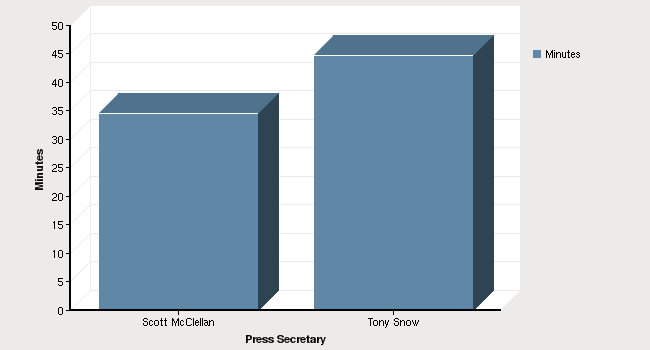There was both a substantive and symbolic changing of the guard when Tony Snow replaced Scott McClellan in May 2006 as White House press secretary.
McClellan—who did not appear to relish verbal jousting with the press and was known for terse responses—was in some ways the symbol of an administration that stayed on message and kept leaks to a minimum. Washington Post media writer Howard Kurtz once memorably described McClellan as “so cautious he makes the man he’s replacing, Ari Fleisher, sound like a gangsta rapper.”
Thus many saw the appointment of Snow—a telegenic and articulate Fox News Channel commentator and radio talk host—as a White House effort to ease relations with journalists and more effectively transmit its message. Snow certainly enjoys the semantic give-and-take with the White House media corps far more than his predecessor did.
Whether Snow reveals any more than McClellan will be for historians to determine. A Washington Post column this week, headlined “Just Call Him Tony‘I Don’t Know’ Snow,” waxed about how many ways the former commentator had to claim he couldn’t answer things.
Stylistically, however, one difference with Snow now in the briefing room appears clearer. He seems to talk a good deal longer than the more laconic McClellan.To find out whether this was more than just an impression, PEJ examined 10 of Snow’s recent press briefings—in late November and December—and compared them with 10 of McClellan’s briefings from the same period a year earlier. The transcripts of these briefings, available on the White House web site, also indicate how long each session took.
The results were eye-catching. The average Snow briefing (45 minutes) lasted slightly more than 10 minutes longer than the average McClellan briefing (35 minutes), an increase of 30%. And after calculating a word count for each briefing, the Project found that the typical Snow session contained about 1,064 more words than the average McClellan go-round—or roughly four extra double spaced pages, or about one and half opinion columns in the New York Times.
Average Length of Press Briefings

What do you get for your extra ten minutes? In a Tony Snow briefing there were roughly 15 more questions—about a 20% increase over McClellan. Of course more questions and longer answers doesn’t necessarily mean more information. But it does suggest that both sides are at it longer.
All the reasonable caveats to these results apply, of course. Some of the issues and discussion topics have changed in the past year, and the journalists themselves have likely played a role in lengthening these sessions. But what is undeniable is that more is being said at these conferences under the Snow regime than during McClellan’s tenure.
Here’s one representative sample of the difference between the two press secretaries.
On Dec. 6, 2005, in response to a series of questions about the U.S. rendering prisoners to nations that might torture, McClellan said, “I’m not going to talk any further about it.” When asked again, he resolutely stated, “We’re not going to comment further than that when it comes to intelligence matters that are helping us to prevent attacks from happening and helping us to learn important intelligence that saves lives.”
Conversely, when Snow was asked on Dec. 12, 2006 what President Bush meant when he said about Iraq, “I’ll be dead when they get it right,” he ended up giving an answer that started with “I don’t know.”
But Snow then proceeded to spend another 337 words—touching on everything and everyone from the Holocaust to George Washington—fleshing out the thought that he didn’t know.



